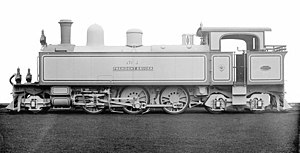2-6-4

Front of locomotive at left
|
|||||||||||||||||

|
|||||||||||||||||
|
|||||||||||||||||
|
|||||||||||||||||
|
|||||||||||||||||
| Equivalent classifications | |
|---|---|
| UIC class | 1C2 |
| French class | 132 |
| Turkish class | 36 |
| Swiss class | 3/6 |
| Russian class | 1-3-2 |
| First known tank engine version | |
|---|---|
| First use | 1898 |
| Country | South African Republic |
| Locomotive | PPR 55 Tonner |
| Railway | Pretoria-Pietersburg Railway |
| Designer | Beyer, Peacock and Company |
| Builder | Beyer, Peacock and Company |
| First known tender engine version | |
|---|---|
| First use | 1901 |
| Country | Cape of Good Hope |
| Locomotive | CGR 6th Class 2-6-4 |
| Railway | Cape Government Railways |
| Designer | H.M. Beatty |
| Builder | Neilson, Reid and Company |
| Evolved from | 4-6-0 |
Under the Whyte notation for the classification of steam locomotives, a 2-6-4 locomotive has two leading wheels, six coupled driving wheels and four trailing wheels. This arrangement is commonly called Adriatic.
With three known exceptions, the Adriatic wheel arrangement was usually used on tank locomotives, for which various suffixes to indicate the type of tank would be added to the wheel arrangement, for example 2-6-4T for an engine with side-tanks.
The earliest known example was the South African Class 6Z, designed by Cape Government Railways (CGR) Chief Locomotive Superintendent H.M. Beatty in 1901. The first engines of the class were modified 2-6-2 Prairie locomotives which were equipped with two-axle trailing bogies. In 1902, more were placed in service, but built with the 2-6-4 wheel arrangement. The latter were the first known tender locomotives in the world to be built with this wheel arrangement.
Tank engines with the 2-6-4 wheel arrangement were produced for many different railway systems worldwide and were mainly used for freight and suburban passenger working. They have been less successful on express passenger trains. The earliest known example also originated in South Africa, the Pretoria-Pietersburg Railway’s 55 Tonner of 1898.
Two Austrian express tender locomotive types were of this wheel arrangement, the Class 210 of 1908 and Class 310 of 1911, both designed by Karl Gölsdorf. The type therefore became known as the Adriatic arrangement, named for the Adriatic Sea which bordered Austria-Hungary until 1918.
Finland had three locomotive classes with a 2-6-4T wheel arrangement, the Classes Vk1, Vk2 and Vk3. All three classes were nicknamed Iita.
...
Wikipedia
